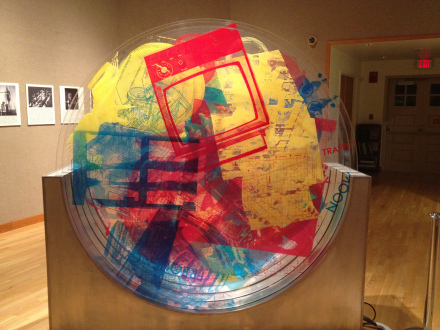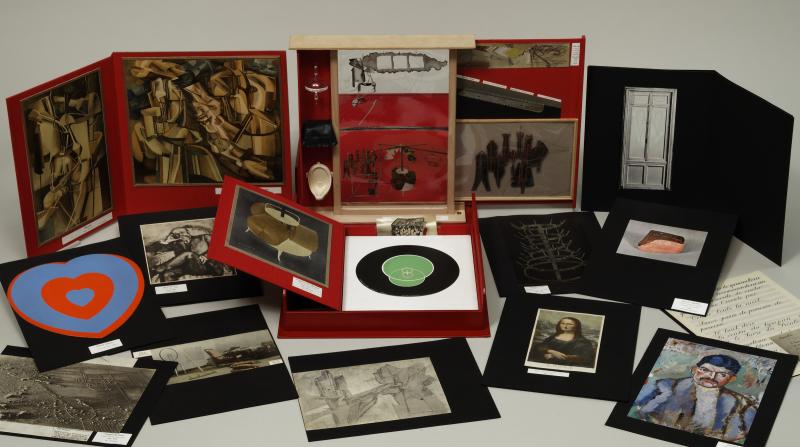This is a long read and covers a lot of ground including: a couple of highlights from the ‘Interior Infinite’ show, a reference to how modern galleries came to be what they are, the tension of hosting the unruly (carnivalesque) in a ‘white cube’ (art gallery), a brief history of Mikhail Bakhtin, and more.
If you’re looking for a succinct article about ‘Interior Infinite’, I highly recommend Dorothy Woodend’s June 30, 2020 article (‘Interior Infinite’: The Rich, Heady and Contentious World of Identity) for The Tyee. There’s also a July 12, 2021 review (“Interior Infinite: Costume, carnival and a celebration of reversal”) by Yani Kong for Galleries West. *I almost forgot Sheri Radford’s July 13, 2021 (“Timely new art exhibit explores self-expression“) for the Daily Hive.*
Interior Infinite
I had expectations based on the exhibit description offered by the Polygon Gallery (from the Interior Infinite webpage on the Polygon Gallery website),
Interior Infinite brings together an international group of artists whose works span photography, video, performance, and sculpture. Predominantly featuring portraiture, with an emphasis on self-portraiture, the exhibition focuses on costume and masquerade [emphasis mine] as strategies for revealing, rather than concealing, identities. Across these works, disguise functions as an unmasking [emphasis mine], as artists construct their own images through adornment in order to visually represent embodied experience, memory, and understanding.
Interior Infinite draws on the spirit of Carnival, a celebration of both radical togetherness and unique self-expression [emphasis mine]. The title is drawn from Rabelais and His World [emphasis mine], an influential text by Mikhail Bakhtin [emphasis mine], which extolled the potential for carnivalesque practices to overcome the limits of repressive conformity and expand our social imagination. The vibrant, fluid, and myriad expressions of identities seen in the exhibition become an act of resistance to erasure, pushing narrow definitions of normativity to include a broader range of lived realities. As Bakhtin writes [emphasis mine]: “The interior infinite could not have been found in a closed and finished world”.
Featuring [artists only; emphasis mine]: Lacie Burning, Claude Cahun, Nick Cave, Charles Campbell, Dana Claxton, Martine Gutierrez, Kris Lemsalu, Ursula Mayer, Meryl McMaster, Zanele Muholi, Aïda Muluneh, Zak Ové, Skeena Reece, Yinka Shonibare CBE, Sin Wai Kin, Carrie Mae Weems, Zadie Xa
Expectations met or exceeded
This is an exciting and stimulating show (running from June 26 – September 5, 2021). It was put together within one year, which is supersonic speed in the art gallery world. (It seems to be one of the features of the COVID-19 pandemic that we are seeing institutions respond in a much more timely fashion than we have learned to expect.)
Here’s curator Justin Ramsey describing the show, which was, in part, a response to the George Floyd murder, in this video produced by Nuvo Magazine (from Nuvo’s June 25, 2021 news item by Ayesha Habib),
Videography by Everett Bumstead.
As you can see in the video, there are some beautiful pieces along with a bit of grotesquerie (Greek goddess Baubo) for a more fully realized carnivalesque experience. (More about the carnivalesque later.)
Estonian artist Kris Lemsalu contributed the Baubo Dance installation consisting of the lower body with jeans, cowboy boots, a representation of the vulva, and a detached head/headdress.
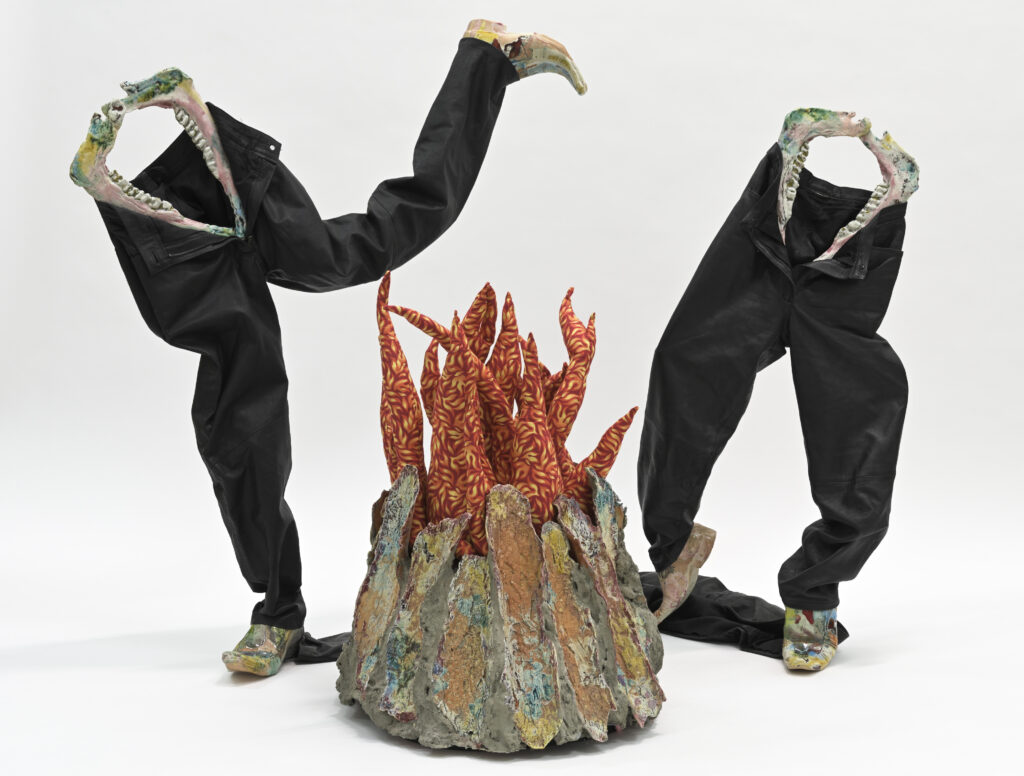
It looks like teeth on the vulva’s opening. I wonder if the artist meant to refer to the vagina dentata in some way (from its Wikipedia entry), Note: Links have been removed,
Vagina dentata (Latin for toothed vagina) describes a folk tale in which a woman’s vagina is said to contain teeth, with the associated implication that sexual intercourse might result in injury, emasculation, or castration for the man involved.
This would make the Baubo figure a bit more edgy than might be expected from reading her Wikipedia entry,
Baubo (Ancient Greek: Βαυβώ) is an old woman in Greek mythology which appears particularly in the myths of the early Orphic religion. Known as the Goddess of Mirth, she was bawdy and sexually liberated, and is said to have jested with Demeter, when Demeter was mourning the loss of her daughter, Persephone. [emphases mine]
…
Figurines known as Baubos are found in a number of settings, usually with Greek connections. They were mass-produced in a number of styles, but the basic figure always exposes the vulva in some way: …
South African artist Zanele Muholi’s photographic work, also featured in the Ramsey video, is beautiful and subtly damning,
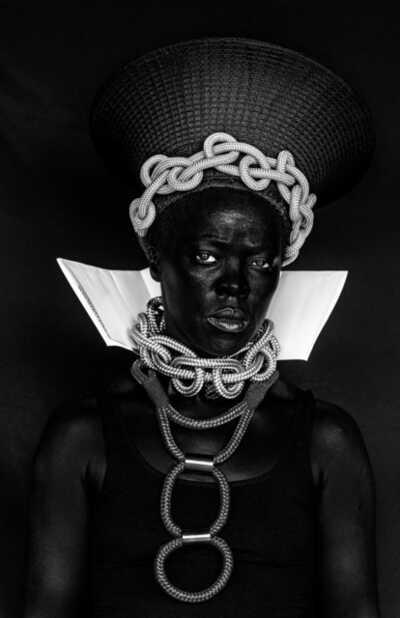
(Not being a photographer or particularly conversant in the visual arts, the following description is in ‘plainish’ language.)
If you look closely, you’ll see the image is layered so you have a background and what looks like a traditional headcovering, tank top, and skin, all in tones of black. The ropes, particularly around the neck and down the chest, suggest (to me, if no one else) entrapment (being roped) and/or a noose. In any event, it’s a very rich image and it’s better seen in person.
If you can get there, know that Muholi has just had their first major survey (retrospective?) in the UK, which was at the Tate Modern (November 5, 2020 – May 31, 2021), Note: A link has been removed,
Zanele Muholi is one of the most acclaimed photographers working today, and their work has been exhibited all over the world. With over 260 photographs, this exhibition presents the full breadth of their career to date.
…
Muholi turns the camera on themself in the ongoing series Somnyama Ngonyama – translated as ‘Hail the Dark Lioness’ [emphasis mine]. These powerful and reflective images explore themes including labour [emphasis mine], racism, Eurocentrism and sexual politics.
The four Muholi works in ‘Interior Infinite’ come from the Somnyama Ngonyama series (excerpted from the Tate Modern’s survey show Exhibition Guide; Room 8),
Somnyama Ngonyama (2012 – ongoing) is a series in which Muholi turns the camera on themself to explore the politics of race and representation. The portraits are photographed in different locations around the world. They are made using materials and objects that Muholi sources from their surroundings.The images refer to personal reflections, colonial and apartheid histories of exclusion and displacement, as well as ongoing racism. They question acts of violence and harmful representations of Black people. Muholi’s aim is to draw out these histories in order to educate people about them and to facilitate the processing of these traumas both personally and collectively.
Muholi considers how the gaze is constructed in their photographs. In some images they look away. In others they stare the camera down, asking what it means for ‘a Black person to look back’. When exhibited together the viewer is surrounded by a network of gazes. Muholi increases the contrast of the images in this series, which has the effect of darkening their skin tone.
I’m reclaiming my Blackness, which I feel is continuously performed by the privileged other. [emphasis mine]
The titles of the works in the series remain in is iZulu, Muholi’s first language. This is part of their activism, taking ownership of and pride in their language and identity. It encourages a Western audience to understand and pronounce the names. This critiques what happened during colonialism and apartheid. Then, Black people were often given English names by their employers or teachers who refused to remember or pronounce their real names.
‘Interior Infinite’ is rich with possibility and you can explore and question various identities both within and without.
There is both an audio guide and an exhibition guide available on Polygon’s Interior Infinite audio guide webpage. (There are also tours of the show much of which is replicated in Justin Ramsey’s July 7, 2021 Curator’s Talk. The video run for over 1 hour.)
The challenge of a theme
“… the genesis of it [Interior Infinite] really was the murder of George Floyd, I thought where is art? How does art respond to a crisis, a catastrophe like this?” says exhibit curator Justin Ramsey in his Nuvo Magazine video interview (embedded earlier in this post).
First challenge: the impetus for the show was a murder
Ramsey’s choice to situate the show as a response to George Floyd’s 2020 murder leads to some interesting tensions within the exhibition (internal) and without (external).
How did Ramsey pick? Ultimately, the question is unlikely to be answered. Incidents which reach beyond the headlines to strike the soul and heart are not easily justifiable or explained to others.
As for Ramsey’s question in the video interview: “How does art respond to a crisis, … ?” The question seems fundamental not only to ‘Interior Infinite’ but more generally to 20th and 21st century art.
The response, in this case, was to pull Bakhtin’s concept of ‘carnival’ , also known as, ‘carnivalesque’ from “Rabelais and His World” allowing Ramsey to use it as a kind of banner under which a number of disparate pieces related to each other and the theme both harmoniously and disharmoniously could be gathered.
What is carnival/carnivalesque?
For a sense of what ‘carnival’ or carnivalesque’ means here’s a description from the Carnivalesque Wikipedia entry (Note: Links have been removed),
Carnivalesque is a literary mode [emphasis mine] that subverts and liberates the assumptions of the dominant style or atmosphere through humor and chaos. It originated as “carnival” in Mikhail Bakhtin’s Problems of Dostoevsky’s Poetics and was further developed in Rabelais and His World. For Bakhtin, “carnival” (the totality of popular festivities, rituals and other carnival forms) is deeply rooted in the human psyche on both the collective and individual level. Though historically complex and varied, it has over time worked out “an entire language of symbolic concretely sensuous forms” [emphasis mine] which express a unified “carnival sense of the world, permeating all its forms”. This language, Bakhtin argues, cannot be adequately verbalized or translated into abstract concepts, but it is amenable to a transposition into an artistic language that resonates with its essential qualities: it can, in other words, be “transposed into the language of literature”. Bakhtin calls this transposition the carnivalization of literature.[1] Although he considers a number of literary forms and individual writers [emphasis mine], it is Francois Rabelais, the French Renaissance author of Gargantua and Pantagruel, and the 19th century Russian author Fyodor Dostoevsky, that he considers the primary exemplars of carnivalization in literature.
…
The carnival sense of the world “is opposed to that one-sided and gloomy official seriousness which is dogmatic and hostile to evolution and change, which seeks to absolutize a given condition of existence or a given social order [emphases mine].”[5] This is not to say that liberation from all authority and sacred symbols was desirable as an ideology. Because participation in Carnival extracts all individuals from non-carnival life, nihilistic and individualistic ideologies are just as impotent and just as subject to the radical humour of carnival [emphasis mine] as any form of official seriousness.[6] The spirit of carnival grows out of a “culture of laughter” [emphasis mine]. Because it is based in the physiological realities of the lower bodily stratum (birth, death, renewal, sexuality, ingestion, evacuation etc.) [emphasis mine], it is inherently anti-elitist: its objects and functions are necessarily common to all humans—”identical, involuntary and non-negotiable”.[7]
Bakhtin argues that we should not compare the “narrow theatrical pageantry” and “vulgar Bohemian understanding of carnival” characteristic of modern times [emphasis mine] with his Medieval Carnival.[8] Carnival was a powerful creative event, not merely a spectacle. Bakhtin suggests that the separation of participants and spectators has been detrimental [emphasis mine] to the potency of Carnival. Its power lay in there being no “outside”: everyone participated, and everyone was subject to its lived transcendence of social and individual norms [emphasis mine]: “carnival travesties: it crowns and uncrowns, inverts rank, exchanges roles, makes sense from nonsense and nonsense of sense.”[9]
So, the response to the murder of George Floyd is that art is opposition to the serious, to the dogmatic. and to resistance to change and evolution by means of the carnivalesque? I think that’s what this show is saying.
(For contrasting views, see Dorothy Woodend’s and Yani Kong’s pieces cited at the beginning of this post.)
2nd Challenge: The carnivalesque in the gallery
Bringing something that by its nature is rude, bawdy, chaotic, loud, smelly, high physical contact, participatory, etc. into an art gallery/museum, an institution not known for its tolerance of the unruly, has to be a fraught proposition.
A man, a cartoon penis, and his four year old daughter (unruliness)
Since 2017 when the Polygon Gallery opened (see a Nov. 18, 2017 article by Ben Bengtson for the North Shore News about the opening), it has had at least one incidence of unruliness (from a February 6, 2020 article by Brent Richter for the North Shore News),
Alex Goldkind was with his four-year-old daughter in Lower Lonsdale Feb. 1 [2020] when a gallery staffer invited them in for their monthly Kids First Saturday event on the upper floor.
On the main level, however, they were given a booklet that accompanies the current collage exhibition called I Spy, by Vancouver artist Elizabeth Zvonar, and were asked to circle images inside as they found them in the large collage on the wall. The first one Goldkind saw on the wall was an 18th century political cartoon depicting Marie Antoinette, Queen of France, with general Marquis de Lafayette, who is riding an ostrich shaped like male genitalia.
“Well, it’s a penis and balls. It’s pretty obvious, right? This is not rocket science here. I was just floored,” he said. “I just grabbed my daughter quickly before she saw it and I walked around the corner, just livid. I tore into all the staff there. I said ‘Are you guys insane? You’re inviting children into this?’”
Staff were so frightened by the outburst, they called the RCMP. [Royal Canadian Mounted Police; emphasis mine]
…
Here’s a photo of the angry parent,
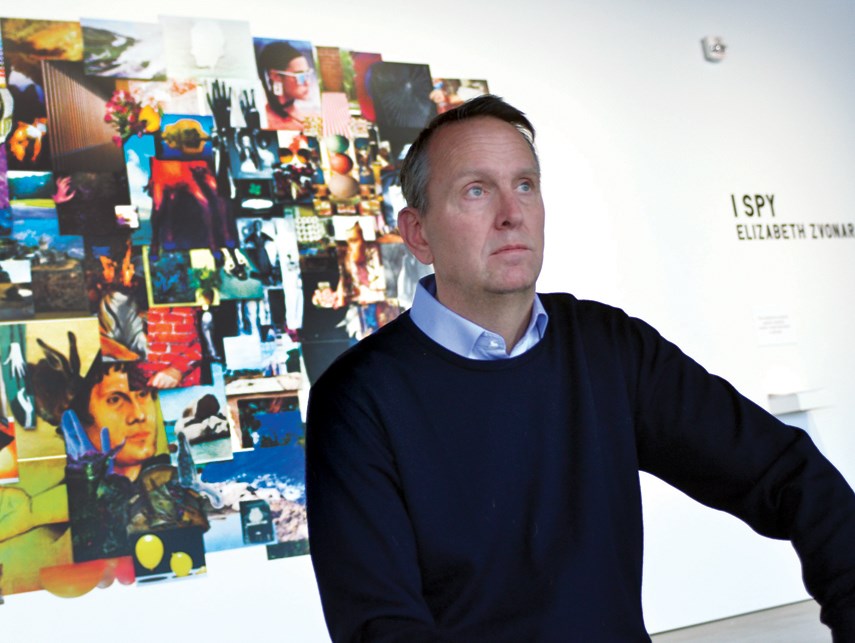
Interestingly, there was an apology—for a lack of signage and clarity.
In addition to difficulty tolerating loud noises and angry people (or other unruliness?), there is at least one other aspect to the challenge of bringing the carnivalesque into an art gallery.
The ‘white cube’ aesthetic
White walls and an antiseptic environment are common in many art galleries built since the 1930s according to Dr. Elizabeth Rodini’s 2018(?) essay, A brief history of the art museum, for the Khan Academy,
… it was in the United States that some of the most influential trends in modern art museums also emerged. One of these is the “white cube” approach which, despite precedents in Europe, was most fully exploited at The Museum of Modern Art in New York City in the 1930s under the direction of Alfred H. Barr. By minimizing visual distractions, Barr hoped to direct viewers toward a pure experience of the art work. The bare spaces, white walls, and minimalist frames he used are now so common that we hardly notice them.
The “white cube” was rooted in a philosophy that aimed to liberate art and artists from the conservative forces of history. Ironically, this model has taken over, and art museums from Rio to Abu Dhabi to Shanghai draw on similar exhibition tactics. This has led some museum critics to wonder if the “white cube” has itself become a vehicle of cultural control [emphasis mine].
…
Rodini goes on to explain further in the comments,
… Its not the whiteness of the walls nor the spare furnishing that are at issue in most critiques of the white cube. Instead, it is the practice of isolating the image and not giving the viewer information [emphasis mine] that would provide details about the object’s origin and its journey from the artist to the museum.This is often done to ensure a “pure” visual experience but it also withholds historical context that can substantially enhance the meaning of a given work of art.
Here’s an image from the slideshow embedded in Ben Bengtson’s Nov. 18, 2017 article about the Polygon Gallery opening,
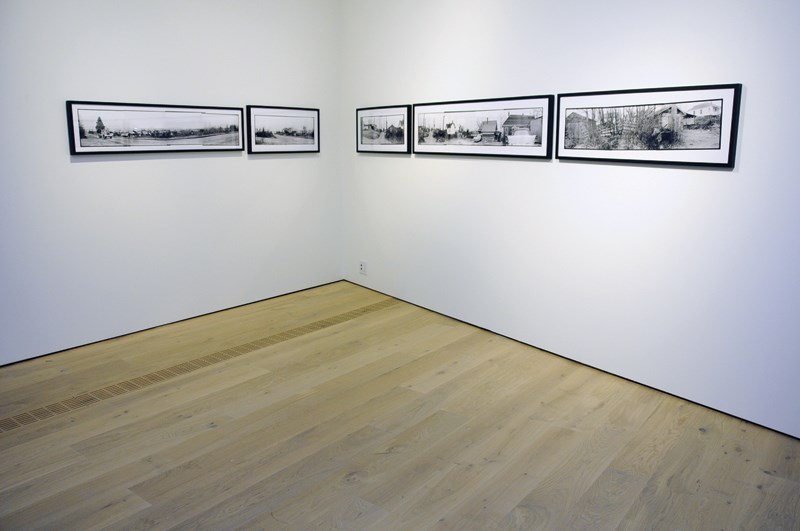
Kudos to Ramsey and the Polygon Gallery folks for assembling a show with a broad range and providing a little context (take a tour or consult the guides provided online) in an environment that is, if not actively hostile, certainly difficult.
(clunk) The other shoe drops
Largely unmentioned during the tour, Bakhtin’s work, specifically the concept of the carnival/canivalesque, was relegated to a couple of mentions in the second paragraph describing the show and a Bakhtin quote from “Rabelais and His World” on a wall somewhere in the show:
“The interior infinite could not have been found in a closed and finished world, with its distinct fixed boundaries dividing all phenomena and values.” [I believe this alludes to Bakhtin’s notions of finalization and unfinalizability]
As it should be, the focus was on the artists. Still, it was a bit disconcerting to walk into a show where a literary theorist (Bakhtin) has supplied the theme and to hear only a single mention in the tour, which described him simply as a philosopher. (Ramsey gave the tour I attended.)
As for the Bakhtin quote, which is used a frame for this show, the tension between a show based on the unfinalizable, chaotic, rude world of the carnivalesque and the closed, finished (finalization) world of an art gallery in ‘Infinite Interior’ is never discussed.
(Segue) Bakhtin: protean thinker and one-legged man in Stalin’s world**
As far as I can tell, no one yet has been able to adequately summarize Bakhtin’s thinking (I’m not going to try), here’s an attempt from his entry on Wikipedia,
Mikhail Mikhailovich Bakhtin (/bʌxˈtiːn/bukh-TEEN; Russian: Михаи́л Миха́йлович Бахти́н, IPA: [mʲɪxɐˈil mʲɪˈxajləvʲɪdʑ bɐxˈtʲin]; 16 November [O.S. 4 November] 1895 – 7 March[2] 1975) was a Russian philosopher, literary critic and scholar who worked on literary theory, ethics, and the philosophy of language [emphases mine]. His writings, on a variety of subjects, inspired scholars working in a number of different traditions (Marxism, semiotics, structuralism, religious criticism) and in disciplines as diverse as literary criticism, history, philosophy, sociology, anthropology and psychology. Although Bakhtin was active in the debates on aesthetics and literature that took place in the Soviet Union in the 1920s, his distinctive position did not become well known until he was rediscovered by Russian scholars in the 1960s.
…
With regard to his personal history, Bakhtin was born in 1895 into a family of nobility and then experienced the 1917 Russian revolution followed by a famine and civil war (1918-21). [As for how Russia fared in the 1918-19 influenza pandemic/epidemic, it was one of at least two others [cholera and typhus] suffered through. See history professor Joshua Sanborn’s March 19, 2020 posting on the Russian History blog for more.)
Bakhtin completed his studies (1918) and was diagnosed with a bone disease (osteomyelitis) in 1923. He was apprehended by Soviet secret police and eventually exiled for six years to Kazakhstan (starting in 1928). Four years after his exile ended, his health improved (1938) when part of his right leg was amputated.
World War II (1939 -45) intervened and despite completing his PhD dissertation (Rabelais and His World) he wasn’t able to defend it until after the war. He seems to have defended it twice, in 1946 and, again, in 1949. The work had proved divisive and he was not awarded a doctoral degree (Doctor of Sciences) but, instead, received a lesser degree, Candidate of Sciences (a research doctorate).
He worked in obscurity for the better part of his life, finally receiving some attention in the mid-1960s when he was about 70. He died in 1975.
For anyone who’s interested in more about Bakhtin, I suggest
- the comprehensive overview in his entry on Wikipedia;
- Nasrullah Mambrol’s January 24, 2018 essay ‘Key Theories of Mikhail Bakhtin‘ on the literariness.org website; and,
- Simon Dentith’s ‘Bakhtinian Thought; an introductory reader‘ (1995) available for free online and available for purchase as a paper copy
And, for the truly dedicated,
- Jennifer Allen Simons’ 1983 PhD dissertation (PDF) ‘Mikhail Bakhtin, Man and his Penultimate Word; a Radical Humanistic Philosophy of the Unfinalizable Whole‘.
- Michael Edward Volek’s 2014 PhD dissertation (PDF) ‘Speaking of Bakhtin: A study of the sociolinguistic discourse on Bakhtin and language‘.
His work, which largely centered on language, written and spoken, with implications that reach far beyond, seems remarkably à propos in this moment but, given his life circumstances, it’s perhaps not entirely a surprise. **Note: There’s more about the circumstances under which Bakhtin lived at the end of this posting.
Sadly, I didn’t learn much about Bakhtin’s work or life during my June 25, 2021 tour given by curator Justin Ramsey. Perhaps I missed it but I wasn’t able to find anything on the Polygon website either;I had to do a lot of subsequent digging to find out more.
Back to Interior Infinite and the dropped shoe
You go upstairs to see the show and at the beginning there’s a description on the wall with a list of all the artists whose work you will be viewing. Oddly, given that there are writers, activists, and philosophers whose work is quoted and can be seen on the walls throughout the show, they did not rate a list beside the artists, nor are they mentioned in any materials about the show. Moving on.
White Cube syndrome and Interior Infinite
I longed for more context, not just with regard to Bakhtin and the carnivalesque, but the artists and the writers too. The audio guide and exhibition guide available on Polygon’s Interior Infinite audio guide webpage are helpful (neither was posted until June 30, 2021 after my visit) and I recommend them as an entry point to the show. There are also tours.
However and this is a good problem to have, the show touches on so many issues of the moment that a general tour is going to be frustrating. I was surprised that there don’t seem to be any plans for themed tours that highlight particular aspects of the show.
During the tour and during his curator’s talk, Ramsey did mention that there will be a drag event later this summer but neither it nor any other future show-related events are listed on the website at this time.
For the curious, the drag event, which is still being organized (according to Ramsey during his curator’s talk), will hopefully feature Shay Dior and the House of Rice (for more about Dior and The House of Rice, there’s a Feb. 7, 2020 news item on the Canadian Broadcasting Corporation’s (CBC) website, “Who run the world? Vancouver drag mother Shay Dior and her growing family of queer Asian kids” by Peter Knegt).
Bringing the ‘outside’ onto art tours
There’s a tendency to assume that people going on tours through an art exhibition are a ‘tabula rasa’, i.e., a blank slate. I’m guessing this is, at least in part, a legacy of education systems that still largely operate on that principle.
Note: I’ve taken more than one tour at various art gallery/museums in Vancouver and have found that the Rennie Museum is the best at including the tour members. Almost certainly the people guiding you through the exhibit will not only invite questions and comments but also allow time for you to respond. Even better, sometimes the guide will include something a tour member told them on a previous tour.
A complete list of the artists and the types of artwork featured
While I have found lists of the artists in the show, there’s only one place where I found a list of each of the types of artwork featured in the show along with the artist who produced them, from artdaily.com’s The Polygon Gallery presents Interior Infinite, a celebration of radical togetherness and unique self-expression webpage (Note: I have made a formatting change; it should be a bulleted list after “The exhibition features:”),
The exhibition features:
A new sculpture by 2020 Phillip B. Lind Emerging Artist Prize runner up Lacie Burning (b. 1992, Brampton, ON) in the Reflection Series, depicting a cloaked figure wearing a mask made of mosaicked mirror fragments
A series of self-portraits by French surrealist photographer Claude Cahun (b. 1894, Nantes, France), whose practice exploring gender and sexual identity was ahead of its time
An original sound piece consisting of birdsong cut into Morse code, as an expansion of Charles Campbell’s (b. 1970, Jamaica) Actor Boy performance series
A soundsuit and video from acclaimed sculptor, dancer, and performance artist Nick Cave (b. 1959, Fulton, Missouri)
A portrait by 2020 Governor General’s Award in Visual and Media Arts recipient Dana Claxton (b. 1959, Yorkton, SK), featuring the artist wearing her collection of handmade leather handbags created by Indigenous artisans
A selection of photographs from Martine Gutierrez’s (b. 1989, Berkeley, California) self-made satirical fashion magazine Indigenous Woman
…
The end
I both love and hate this show. It is rich with ideas and possibilities.
George Floyd
One of the reason this show is so difficult to embrace is that It’s hard to imagine someone like George Floyd (Wikipedia entry) who had a criminal record and was struggling at the time of his death would have felt welcome at Polygon’s ‘Interior Infinite’. BTW, my father would not have felt comfortable either. In his case, the issue would have been social class.
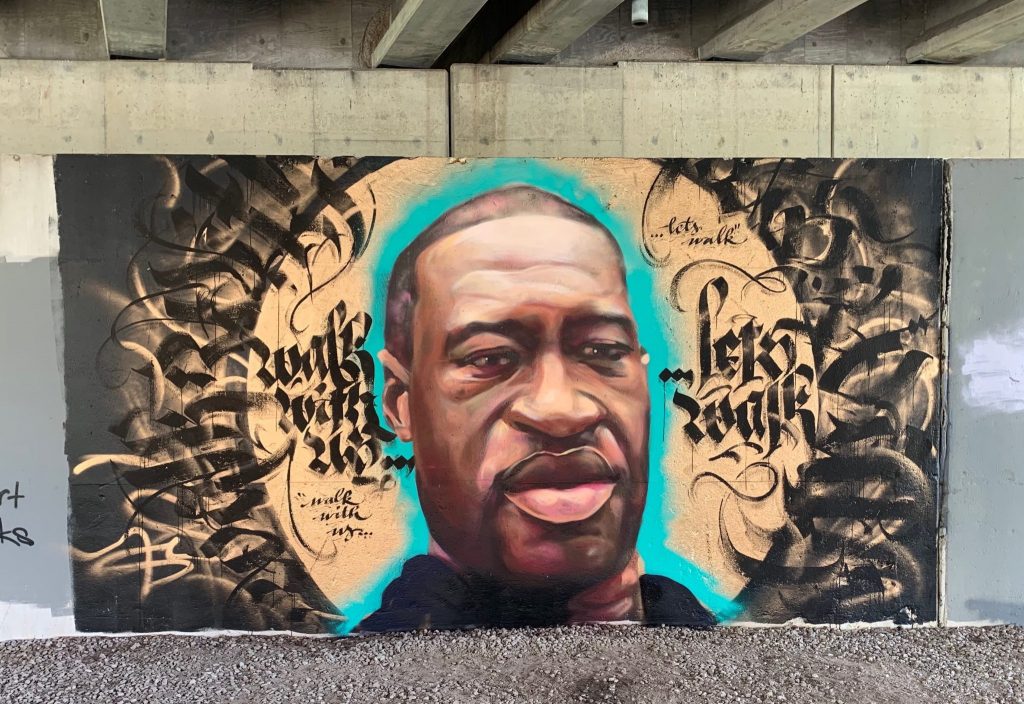
Given that his murder was the impetus for ‘Interior Infinite’, I expected to see some mention of him in the gallery or on the exhibition’s webpage.
Writers?
As a writer, I’m disappointed (but unsurprised) that the people who provided text for the quotes on the gallery walls were not listed on the wall beside the list of artists. It’s almost as if the quotes are wallpaper.
Identity confusion
As for the Trinidad and Tobago Carnival (Ramsey repeatedly refers to the Trinidad Carnival in his July 7, 2021 Curator’s Talk) that seems more egregious in a showcase for identity and given there’s a local version of the carnival, Caribbean Days Festival, held fairly close to the Polygon Gallery every July for over 30 years (the 2021 edition has been cancelled). And yes, it’s organized by the Trinidad and Tobago Cultural Society of British Columbia.
More Bakhtin
Deeply thoughtful with regard to the artworks on display and social justice issues, It would have been helpful if Ramsey had shared more about how Bakhtin’s carnivalesque is invoked in this show. It’s as if the staff at the Polygon let me smell the baking but never offered me any cinnamon buns. How does the Bakhtin quote which alludes to his concepts of unfinalizability and finalization play a role in ‘Interior Infinite’?
Any Bakhtin scholars out there care to respond? Please do.
No mention of COVID-19 masks
In a show featuring masks, how do you not mention COVID-19 or any of the current discussion about masks? It’s one of the more curious omissions in the show.
A couple of thoughts
It seems to me that Ramsey let the show, the carnivalesque, and Bakhtin get away from him. The impulse towards finalization overcame him and so he presents the show, in his curator’s talk, as ‘art’s response’ to the murder of George Floyd and other instances of repression.
By contrast, Bakhtin’s carnivalesque in “Rabelais and His World” presents unfinalizability in the rude, bawdy, smelly, chaotic, loud, dangerous, grotesque place where identities are mocked, inverted, and made fun of.
Ultimately, Ramsey never grapples with (or even seems to acknowledge) the paradox at the heart of his project.
The failure doesn’t matter. Go see ‘Interior Infinite’ anyway. it’s worth the trip to the gallery. And, if you’re inclined, bring your carnivalesque spirit.
PS: If you see any mistakes or have any comments, please let me know via the commenting feature on this blog.
*Sheri Radford’s July 13, 2021 article for the Daily Hive added on July 26, 2021 at 13:40 PDT.
**July 28, 2021: The subhead “(Segue) Bakhtin: protean thinker and one-legged man in Stalin’s world” was corrected (‘and’ replaced ‘with’) and here’s more about the Bakhtin’s circumstances from Caryl Emerson’s “The First Hundred Years of Michail Bakhtin” 1997, Princeton University Press,
When Maxim Gorky laid down the Socialist Realist “rules” for creative literature in the Stalinist 1930s, and when Mikhail Bakhtin, then in political exile in Kazakhstan, wrote hundreds of pages that refuted those rules by invoking as exemplary ***different*** genres and different authors, both men were acting wholly within the tradition of Russian literary culture. For unlike America in much of its modern phase, literary accomplishment and criticism in Russia has mattered. You could get arrested and killed [emphasis mine] for it; thus educated society revered its poets and considered literary progress to be a bellwether of its own. (p. 10)
***July 29, 2021: ‘differed’ changed to ‘different
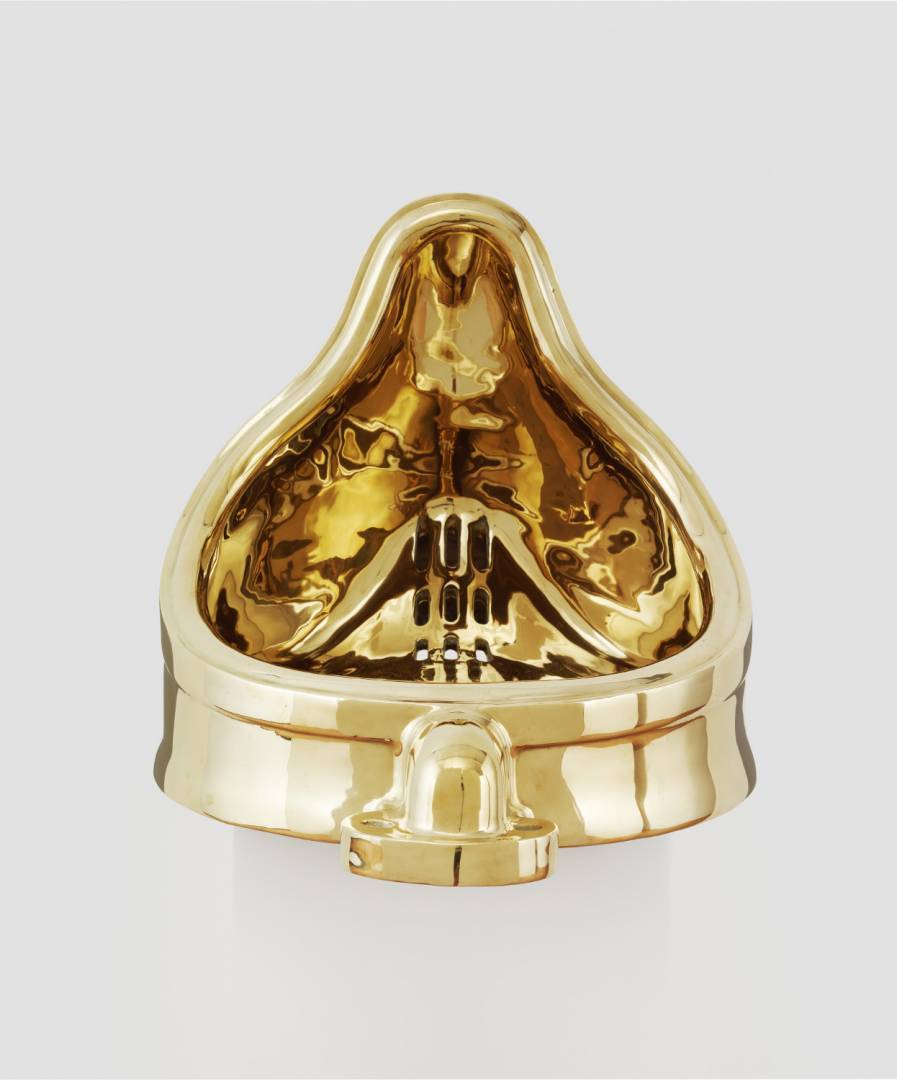
![The original Fountain by Marcel Duchamp photographed by Alfred Stieglitz at the 291 (Art Gallery) after the 1917 Society of Independent Artists exhibit. Stieglitz used a backdrop of The Warriors by Marsden Hartley to photograph the urinal. The entry tag is clearly visible. [downloaded from https://en.wikipedia.org/wiki/Fountain_%28Duchamp%29]](http://www.frogheart.ca/wp-content/uploads/2016/03/MarcelDuchampsUrinal.jpg)
